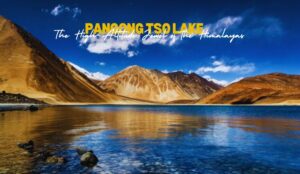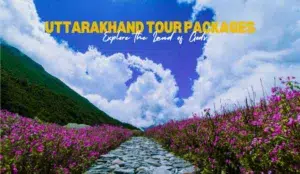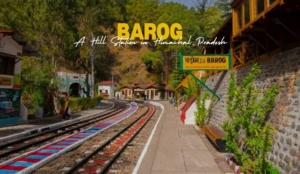“Explore the Mystical Beauty of Dokriani Glacier ❄️ | Discover Hidden Wonders in 2023 🏞️ | Don’t Miss Out! #NatureLovers”
About Dokriani Glacier:
- Location: Dokriani Glacier is located in the Indian state of Uttarakhand, specifically within the Uttarkashi district of the Garhwal Himalayas. It lies in the western part of Uttarakhand and is a part of the larger Gangotri Glacier system, one of the largest glaciers in the Himalayas. This glacier is situated at high altitudes, contributing to the origin of the Bhagirathi River, one of the primary tributaries of the Ganges River.
- Geological Significance: This glacier is a remarkable example of a valley glacier, formed by the accumulation of snow and ice over centuries.
- Size and Shape: Covering an area of approximately 5 square kilometers, Dokriani Glacier displays a distinctive “U” shape, characteristic of glaciers carved by glacial erosion.
- Altitude: The glacier starts at an elevation of around 3,700 meters (12,139 feet) and descends to about 3,000 meters (9,842 feet).
- Source of Water: It serves as a vital source of water for the Bhagirathi River, which eventually joins the Ganges River.
- Natural Beauty: Dokriani Glacier is renowned for its pristine, untouched beauty, surrounded by towering peaks and dense alpine forests.
History of Dokriani Glacier:
- Scientific Exploration: The glacier has been a subject of interest for geologists, glaciologists, and adventurers, who have studied its dynamics and history.
- Historical Significance: While not as well-known as some other Himalayan glaciers, Dokriani has its own historical importance in the context of glaciological research.
- Environmental Changes: Over the years, the glacier has witnessed changes due to climate shifts, serving as a valuable case study for climate scientists.
- Adventures and Expeditions: Various mountaineers and adventurers have trekked to Dokriani Glacier, contributing to its documented history.
- Conservation Efforts: Given the global concern for glacial retreat, Dokriani Glacier has gained attention in conservation discussions, emphasizing the need to protect these vital water sources.
- Cultural Relevance: The glacier is also relevant in local folklore and culture, playing a role in the traditions and stories of the indigenous communities in the region.
Dokriani Glacier’s unique geological features and historical importance make it a fascinating subject for those interested in nature, science, and adventure.
Facts about Dokriani Glacier:
- Remote Location: Dokriani Glacier is situated in the remote and rugged terrain of the Garhwal Himalayas, far from urban areas, adding to its untouched beauty.
- Ice Formation: Like all glaciers, Dokriani forms from the accumulation and compaction of snow over thousands of years, gradually transforming into ice.
- Sustaining Rivers: It serves as a crucial source for feeding the Bhagirathi River, which eventually merges with the Ganges, providing water to millions of people downstream.
- Glacial Retreat: Over the last few decades, Dokriani Glacier has experienced noticeable retreat, a concerning indicator of climate change’s impact on Himalayan glaciers.
- Unique Shape: Its “U”-shaped valley and the surrounding mountainous landscape make it visually striking and photogenic.
- Scientific Research: Scientists study Dokriani Glacier to understand glacial behavior, helping to predict future water resource availability in the region.
- Trekking Destination: Adventurers and trekkers are drawn to this glacier for its challenging but rewarding treks, offering panoramic views of the Himalayas.
- Local Communities: The glacier’s meltwater supports agriculture and sustains local communities in the region, making it vital for their livelihoods.
- Conservation Concerns: Dokriani Glacier’s retreat raises concerns about water security, prompting discussions on sustainable water resource management.
- Biodiversity: The surrounding area hosts diverse flora and fauna adapted to high-altitude conditions, adding to the glacier’s ecological significance.
- Cultural Importance: It features in local legends and traditions, enriching the cultural heritage of the Garhwal Himalayas.
- Challenging Environment: Dokriani’s extreme altitude and harsh weather conditions make it a challenging yet rewarding destination for mountaineers and explorers.
These facts collectively contribute to the intrigue and significance of Dokriani Glacier, highlighting both its natural beauty and its role in environmental and cultural contexts.
Why Dokriani Glacier is Famous:
- Natural Splendor: Dokriani Glacier is renowned for its breathtaking natural beauty, characterized by pristine ice formations, towering peaks, and awe-inspiring landscapes.
- Remote Location: Its remote location in the Garhwal Himalayas adds to its fame, attracting adventurers and nature enthusiasts seeking off-the-beaten-path experiences.
- Scientific Interest: The glacier’s unique geological features and glacial dynamics make it a subject of interest for scientists and researchers, contributing to its fame in academic circles.
- Water Source: Dokriani Glacier is a vital source of freshwater for the Bhagirathi River, which is part of the Ganges River system, making it culturally and ecologically significant.
- Trekking Destination: Adventure seekers flock to Dokriani Glacier for challenging trekking opportunities, providing a chance to explore its pristine surroundings.
Things to Do in Dokriani Glacier:
- Trekking Adventures: Trekking to Dokriani Glacier is a must-do activity, offering a thrilling journey through rugged terrain and rewarding trekkers with panoramic Himalayan views.
- Photography: Capture the mesmerizing beauty of the glacier, surrounding peaks, and the changing hues of the ice, creating lasting memories.
- Wildlife Observation: Spot unique high-altitude wildlife, such as Himalayan tahrs and various bird species, in their natural habitat.
- Scientific Exploration: Learn about glaciology and environmental science by observing the glacier’s features and studying its behavior.
- Camping: Enjoy the serenity of the Himalayan wilderness by camping near the glacier, under the star-studded sky.
- Cultural Immersion: Interact with local communities to learn about their traditions, customs, and the cultural significance of the glacier.
- Environmental Conservation: Join or support initiatives focused on preserving the glacier and its fragile ecosystem.
- Adventure Sports: For the daring, consider ice climbing, rappelling, or mountaineering expeditions in the vicinity.
- Educational Tours: Participate in guided tours led by experts who provide insights into the glacier’s history, geology, and climate impact.
- Nature Meditation: Seek solace in the serene surroundings, meditating amidst the natural beauty of Dokriani Glacier.
Visiting Dokriani Glacier offers a unique blend of adventure, natural wonder, and cultural experiences, making it a destination of choice for diverse travelers and explorers.
Things to Know about Dokriani Glacier:
- Location: Dokriani Glacier is situated in the Garhwal Himalayas of Uttarakhand, India, in the Chamoli district.
- Glacial Characteristics: It is a valley glacier, shaped like a “U,” formed by the accumulation and compaction of snow and ice over centuries.
- Size: Covering an area of approximately 5 square kilometers, Dokriani Glacier is relatively small compared to some of its neighboring glaciers.
- Altitude: The glacier starts at an elevation of around 3,700 meters (12,139 feet) and descends to about 3,000 meters (9,842 feet).
- Water Source: Dokriani Glacier feeds the Bhagirathi River, contributing to the Ganges River system, and plays a crucial role in providing freshwater downstream.
- Scientific Significance: Scientists study Dokriani Glacier to understand glacial dynamics, climate change impact, and the implications for water resource management.
- Trekking Challenges: The trek to Dokriani Glacier is considered moderately challenging, requiring physical fitness and proper gear due to its remote and high-altitude location.
How to Reach Dokriani Glacier:
- By Air: The nearest airport is Jolly Grant Airport in Dehradun, approximately 250 kilometers away. From there, you can hire a taxi or take a bus to reach the base point of the trek.
- By Train: Rishikesh and Haridwar are the nearest major railway stations. Both are well-connected to various cities in India. From these towns, you can proceed by road to the glacier.
- By Road: Drive or take a bus from major cities like Dehradun, Rishikesh, or Haridwar to Joshimath, which is a common starting point for treks to Dokriani Glacier.
- Trekking Route: The trek typically starts from Joshimath and takes you through picturesque villages like Dhak, Lata, and Suraithota, eventually leading to Dokriani Glacier. Guides and local support are advisable for the trek.
- Permit: Ensure you obtain the necessary permits from the forest department or authorities in Joshimath before embarking on the trek, as it involves sensitive ecological zones.
- Best Time to Visit: The ideal time to visit Dokriani Glacier is during the summer months, from May to June and September to October, when the weather is relatively stable.
- Preparation: Due to the challenging terrain and altitude, prepare with proper trekking gear, acclimatization, and a local guide for safety.
- Accommodation: Limited accommodations are available in the nearby villages, but camping is a popular choice for trekkers.
Reaching Dokriani Glacier requires a combination of air, train, and road travel followed by a trek, but the journey is rewarding, offering a glimpse into the pristine beauty of the Himalayas.
Travel Tips for Dokriani Glacier:
- Acclimatization: Prioritize acclimatization to high altitudes to prevent altitude sickness. Spend a day or two at lower elevations like Joshimath before starting the trek.
- Fitness Preparation: Undertake physical fitness training before the trip, as the trek can be demanding, with steep ascents and descents.
- Local Guide: Hire a local guide who knows the terrain, weather conditions, and the best routes to ensure a safe and enjoyable trek.
- Pack Light: Carry only essential items, as heavy backpacks can make the trek more challenging. Include warm clothing, rain gear, and a first-aid kit.
- Water and Hydration: Stay well-hydrated by carrying a reusable water bottle and purification tablets, as clean water sources may be limited along the route.
- Trekking Permits: Obtain trekking permits and necessary documentation from authorities in Joshimath or the nearest town before starting the trek.
- Emergency Contacts: Keep emergency contact numbers and the contact information of local authorities and rescue services handy.
- Cash and Essentials: Bring enough cash, as ATMs might not be readily available in remote areas. Also, carry essentials like a torch, extra batteries, and a power bank.
Best Time to Visit Dokriani Glacier:
- Late Spring to Early Summer (May-June): This period offers the best weather conditions with clear skies and comfortable temperatures, making it ideal for trekking and sightseeing.
- Post-Monsoon (September-October): After the monsoon season, the weather stabilizes, and the landscape becomes lush and vibrant. This is another excellent time to visit.
- Winter (November-April): The glacier is accessible during winter, but extreme cold and heavy snowfall make it challenging. Only experienced trekkers should consider this season.
- Monsoon Season (July-August): Monsoon rains can make the terrain slippery and unsafe for trekking. It’s advisable to avoid Dokriani Glacier during this time.
- Wildflower Blooms: If you’re interested in wildflowers, visit in late spring or early summer when the meadows around the glacier burst into colorful blooms.
- Wildlife Sightings: Late summer and early autumn are also good for spotting wildlife as many animals become more active during this time.
Choosing the best time to visit Dokriani Glacier depends on your preferences, but planning during the recommended seasons will enhance your overall experience and safety during the journey.
Places to Eat Near Dokriani Glacier:
- Local Eateries in Joshimath: Before embarking on your trek to Dokriani Glacier, you can explore the town of Joshimath, which offers a variety of local eateries serving North Indian cuisine. Try some regional dishes and get a taste of the local flavors.
- Cafes and Restaurants in Auli: Auli, a popular skiing destination near Joshimath, is known for its cafes and restaurants. You can enjoy meals with a view of the Himalayan peaks. Don’t miss trying Garhwali dishes like Aloo Ke Gutke and Mandua Ki Roti.
- Pack Your Own Meals: Given the remote nature of the trek to Dokriani Glacier, it’s advisable to carry packed meals or snacks. You can prepare sandwiches, energy bars, and carry dry fruits for sustenance during the trek.
- Local Villages: Along the trekking route, you may come across local villages where you can interact with residents and, on occasion, request simple meals or tea. It’s a unique opportunity to experience local hospitality.
- Campfire Cooking: If you’re camping near Dokriani Glacier, consider bringing portable camping stoves or equipment to prepare your meals. Cooking under the starry Himalayan sky can be a memorable experience.
Nearby Places to Dokriani Glacier:
- Auli: Auli, situated about 15 kilometers from Joshimath, is not only a ski resort but also a picturesque destination surrounded by oak and coniferous forests. It’s a great place for nature walks and offers panoramic views of the Himalayas.
- Bhavishya Badri: Located on the way to the glacier, Bhavishya Badri is one of the Panch Badri temples and is dedicated to Lord Narasimha. It’s a religious site and a place for quiet contemplation.
- Tapovan: Tapovan, another trekking destination, is known for its hot springs and the Bhagirathi River. It’s a serene spot for relaxation and offers excellent trekking opportunities.
- Vishnuprayag: This is one of the five confluences of the Alaknanda River in the Garhwal region. It’s a picturesque spot where the Dhauliganga River meets the Alaknanda River.
- Malari: A remote village near Dokriani Glacier, Malari provides insights into the traditional lifestyle of the locals and offers an opportunity for cultural immersion.
- Nanda Devi National Park: This UNESCO World Heritage Site is renowned for its biodiversity and includes trekking routes that pass near Dokriani Glacier. It’s a pristine wilderness area that’s worth exploring.
Visiting these nearby places and savoring local cuisine can enhance your experience while journeying to Dokriani Glacier, offering a well-rounded adventure in the Garhwal Himalayas.
Conclusion:
In conclusion, Dokriani Glacier stands as a gem in the crown of the Garhwal Himalayas, offering a blend of natural beauty, scientific significance, and cultural relevance. Its unique “U”-shaped valley and remote location make it an enticing destination for trekkers, adventure enthusiasts, and those seeking a glimpse of the pristine Himalayan wilderness.
This glacier, while relatively small in comparison to some of its neighbors, holds immense importance as a water source for the Bhagirathi River, contributing to the broader Ganges River system. It also serves as a living laboratory for scientists studying glacial behavior and climate change impact.
For travelers, Dokriani Glacier presents both challenges and rewards. Proper preparation, acclimatization, and local guidance are crucial for a safe and enjoyable trek. Exploring nearby attractions like Auli, Bhavishya Badri, and Tapovan further enriches the experience.
As we tread cautiously in the wake of climate change and its effects on glaciers, Dokriani serves as a poignant reminder of the need for responsible tourism and environmental conservation in the Himalayan region.
FAQs (Frequently Asked Questions):
1. Is it safe to visit Dokriani Glacier?
- While Dokriani Glacier is a stunning destination, trekking in the high-altitude terrain poses challenges. Safety precautions include proper acclimatization, hiring local guides, and checking weather conditions.
2. What’s the best time to visit Dokriani Glacier?
- The best times are late spring to early summer (May-June) and post-monsoon (September-October) when the weather is favorable. Winter visits are possible but challenging, while the monsoon season (July-August) is best avoided.
3. Are there accommodations near Dokriani Glacier?
- Accommodations are limited in nearby villages. Trekkers often opt for camping. In towns like Joshimath and Auli, you’ll find a range of hotels and guesthouses.
4. How do I reach Dokriani Glacier from major cities in India?
- Accessible cities like Dehradun, Rishikesh, and Haridwar serve as starting points. You can travel by air, train, and road to reach Joshimath, the base for the trek.
5. What is the significance of Dokriani Glacier in the context of climate change?
- Dokriani Glacier, like many Himalayan glaciers, has been impacted by climate change, experiencing retreat. Its study contributes to our understanding of glacial behavior and its implications for freshwater resources and ecosystems.





